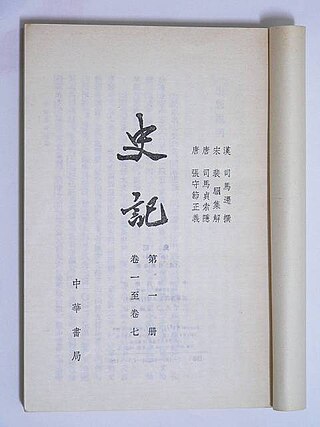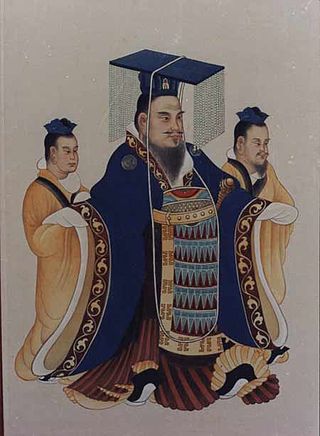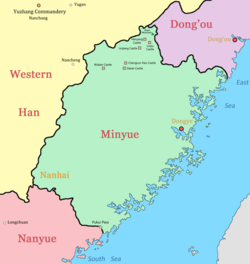This article concerns the period 119 BC – 110 BC.
This article concerns the period 139 BC – 130 BC.
Year 135 BC was a year of the pre-Julian Roman calendar. At the time it was known as the Year of the Consulship of Flaccus and Piso and the Sixth Year of Jianyuan. The denomination 135 BC for this year has been used since the early medieval period, when the Anno Domini calendar era became the prevalent method in Europe for naming years.
Year 110 BC was a year of the pre-Julian Roman calendar. At the time it was known as the Year of the Consulship of Rufus and Albinus and the First Year of Yuanfeng. The denomination 110 BC for this year has been used since the early medieval period, when the Anno Domini calendar era became the prevalent method in Europe for naming years.
Year 111 BC was a year of the pre-Julian Roman calendar. At the time it was known as the Year of the Consulship of Serapio and Bestia and the Sixth Year of Yuanding. The denomination 111 BC for this year has been used since the early medieval period, when the Anno Domini calendar era became the prevalent method in Europe for naming years.

The Shiji, often known in English as Records of the Grand Historian or The Grand Scribe's Records, is a Chinese historical text that is the first of the Twenty-Four Histories of imperial China. It was written during the late 2nd and early 1st centuries BC by the Han dynasty historian Sima Qian, building upon work begun by his father Sima Tan. The work covers a 2,500-year period from the age of the legendary Yellow Emperor to the reign of Emperor Wu of Han in the author's own time, and describes the world as it was known to the Chinese of the Western Han dynasty.

Emperor Wu of Han, born Liu Che and courtesy name Tong, was the seventh emperor of the Han dynasty from 141 to 87 BC. His reign lasted 54 years – a record not broken until the reign of the Kangxi Emperor more than 1,800 years later – and remains the record for ethnic Han emperors. His reign resulted in a vast expansion of geopolitical influence for the Chinese civilization, and the development of a strong centralized state via governmental policies, economical reorganization and promotion of a hybrid Legalist–Confucian doctrine. In the field of historical social and cultural studies, Emperor Wu is known for his religious innovations and patronage of the poetic and musical arts, including development of the Imperial Music Bureau into a prestigious entity. It was also during his reign that cultural contact with western Eurasia was greatly increased, directly and indirectly.

The Baiyue, Hundred Yue, or simply Yue, were various ethnic groups who inhabited the regions of Southern China and Northern Vietnam during the 1st millennium BC and 1st millennium AD. They were known for their short hair, body tattoos, fine swords, and naval prowess.

Dayuan is the Chinese exonym for a country that existed in Ferghana valley in Central Asia, described in the Chinese historical works of Records of the Grand Historian and the Book of Han. It is mentioned in the accounts of the Chinese explorer Zhang Qian in 130 BCE and the numerous embassies that followed him into Central Asia. The country of Dayuan is generally accepted as relating to the Ferghana Valley, controlled by the Hellenistic city-state Alexandria Eschate, which can probably be understood as "Greco-Fergana city-state" in English language.

Zhao Tuo, rendered as Triệu Đà in Vietnamese, was a Qin dynasty Chinese general and first emperor of Nanyue. He participated in the conquest of the Baiyue peoples of Guangdong, Guangxi and Northern Vietnam. After the fall of the Qin, he established the independent kingdom of Nanyue with its capital in Panyu in 204 BCE. Some traditional Vietnamese history scholars considered him the founder of the Triệu dynasty while some contemporary historians contest that he was a foreign invader.

Zhao Mo was the second ruler of Nanyue. He succeeded his grandfather Zhao Tuo in 137 BC and reigned until his death in 124 BC.

The Triệu dynasty or Zhao dynasty ruled the kingdom of Nanyue, which consisted of parts of southern China as well as northern Vietnam. Its capital was Panyu, in modern Guangzhou. The founder of the dynasty, Zhao Tuo, was a Chinese general from Hebei and originally served as a military governor under the Qin dynasty. He asserted the state's independence in 207 BC as the Qin dynasty was collapsing. The ruling elite included both native Yue and immigrant Han peoples. Zhao Tuo conquered the Vietnamese state of Âu Lạc and led a coalition of Yuè states in a war against the Han dynasty, which had been expanding southward. Subsequent rulers were less successful in asserting their independence and the Han dynasty finally conquered the kingdom in 111 BC.

Minyue was an ancient kingdom in what is now the Fujian province in southern China. It was a contemporary of the Han dynasty, and was later annexed by the Han empire as the dynasty expanded southward. The kingdom existed approximately from 306 BC to 110 BC.
The Âu Việt or Ouyue were an ancient conglomeration of Baiyue tribes living in what is today the mountainous regions of northernmost Vietnam, western Guangdong, and northern Guangxi, China, since at least the third century BCE. They were believed to have belonged to the Tai-Kadai language group. In eastern China, the Ouyue established the Dong'ou or Eastern Ou kingdom. The Western Ou were other Baiyue tribes, with short hair and tattoos, who blackened their teeth and are the ancestors of the modern upland Tai-speaking minority groups in Vietnam such as the Nùng and Tay, as well as the closely related Zhuang people of Guangxi.
Zhao Yingqi was the son of Zhao Mo and the third ruler of the kingdom of Nanyue. His rule began in 122 BC and ended with his death in 115 BC.
Zhao Jiande was the last king of Nanyue. His rule began in 112 BC and ended in the next year. He was executed by Western Han forces during the reign of Emperor Wu of Han.

The southward expansion of the Han dynasty was a series of Chinese military campaigns and expeditions in what is now modern Southern China and Northern Vietnam. Military expansion to the south began under the previous Qin dynasty and continued during the Han era. Campaigns were dispatched to conquer the Yue tribes, leading to the annexation of Minyue by the Han in 135 BC and 111 BC, Nanyue in 111 BC, and Dian in 109 BC.

The Han campaigns against Minyue were a series of three Han military campaigns dispatched against the Minyue state. The first campaign was in response to Minyue's invasion of Eastern Ou in 138 BC. In 135 BC, a second campaign was sent to intervene in a war between Minyue and Nanyue. After the campaign, Minyue was partitioned into Minyue, ruled by a Han proxy king named Zou Yushan, and Dongyue. During the concluding months of 111 BC, after the unsuccessful uprising led by Zou Yushan in thwarting General Yang Pu's conspiratorial intentions to undermine him, the aspiration for autonomous rule in Dongyue gradually waned. The rebellion instigated by Zou was suppressed, prompting the Han dynasty's complete annexation of Dongyue into its dominion and the conquest of the residual territories that constituted the former Minyue, effectively consolidating the permanent integration of both domains into the Han empire indefinitely.

The military of the Han dynasty was the military apparatus of China from 202 BC to 220 AD, with a brief interregnum by the reign of Wang Mang and his Xin dynasty from 9 AD to 23 AD, followed by two years of civil war before the refounding of the Han.
Queen Jiu or Cù Hậu, was a queen consort and regent of Nanyue. She was originally from Handan. She was married to King Zhao Yingqi and was the mother of king Zhao Xing. She served as regent of Nanyue during the minority of her son between 113 and 112 BC. She and her son were deposed and murdered by prime minister Lü Jia for having submitted to the Han dynasty as vassals.












